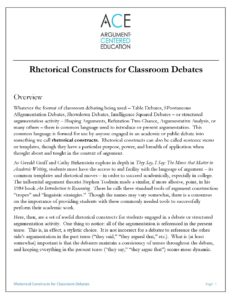
Rhetorical Constructs: Essential Tools of Classroom Debate
Overview
Whatever the format of classroom debating being used – Table Debates, SPontaneous ARgumentation Debates, Showdown Debates, Intelligence Squared Debates – or structured argumentation activity – Shaping Arguments, Refutation Two-Chance, Argumentative Analysis, or many others – there is common language used to introduce or present argumentation. This common language is formed for use by anyone engaged in an academic or public debate into something we call rhetorical constructs. Rhetorical constructs can also be called sentence stems or templates, though they have a particular purpose, power, and breadth of application when thought about and taught in the context of argument.
As Gerald Graff and Cathy Birkenstein explore in depth in They Say, I Say: The Moves that Matter in Academic Writing, students must have the access to and facility with the language of argument – its common templates and rhetorical moves – in order to succeed academically, especially in college. The influential argument theorist Stephen Toulmin made a similar, if more allusive, point, in his 1984 book An Introduction to Reasoning. There he calls these standard tools of argument construction “tropes” and “linguistic strategies.” Though the names may vary somewhat, there is a consensus on the importance of providing students with these commonly needed tools to successfully perform their academic work.
Here, then, are a set of useful rhetorical constructs for students engaged in a debate or structured argumentation activity. One thing to notice: all of the argumentation is referenced in the present tense. This is, in effect, a stylistic choice. It is not incorrect for a debater to reference the other side’s argumentation in the past tense (“they said,” “they argued that,” etc.). What is (at least somewhat) important is that the debaters maintain a consistency of tenses throughout the debate, and keeping everything in the present tense (“they say,” “they argue that”) seems more dynamic.
Initial Arguments/Case Arguments
- My name is _____________________, and I am arguing that [insert overall position]. My first argument is [insert argumentative claim]. [Follow with evidence and reasoning. Avoid using the phrase: “My evidence for this is _____________.” Simply begin stating the evidence and reasoning.]
- My name is ___________________. On the question [insert debatable issue], I/we take the position that [insert overall position]. One reason for this is [insert argumentative claim]. [Follow with evidence and reasoning.]
- My second argument is [insert argumentative claim]. [Follow with evidence and reasoning.]
- Another reason that I/we believe that [insert overall position] is that [insert argumentative claim.] [Follow with evidence and reasoning.]
Counter-Arguments
- My name is _____________________, and I will be responding to the other side’s case [or opening] They first argue that [insert their first argumentative claim.] I/We disagree with that. [Insert counter-argument, starting with the claim, then following with the evidence and reasoning.]
- A second reason we disagree with their claim that [repeat their argumentative claim] is that [insert second counter-argument.]
- Also, [insert second counter-argument.]
- Secondly, [insert second counter-argument.]
- My name is _____________________, and I will be responding to the other side’s case [or opening] They first argue that [insert their first argumentative claim,] but their evidence to support that claim is weak. The evidence says that [insert interpretation or reasoning of the evidence that exposes a flaw or weakness.] It doesn’t say that [insert their interpretation or reasoning of the evidence.] They haven’t supported this claim which means that [statement of the impact that this has on support for their overall position.]
- I will be addressing the [affirmative or negative] team’s arguments. First, they say [insert argumentative claim.] That isn’t true. [Insert counter-argument, starting with the claim, then following with the evidence and reasoning.]
- They also argue that [insert their second argumentative claim.] But their evidence doesn’t support this claim. Their evidence would need to say [insert reasoning that would apply to evidence that is aligned, credible, sufficient to support their claim.] It doesn’t say that. It actually says [insert reasoning that shows that the evidence is not aligned, credible, or sufficient.] This means that this argument isn’t true that therefore [statement of the impact that this has on support for their overall position.]
Rebuttal
- We are/I am arguing that [insert original argumentative claim.] They counter-argue that [insert counter-claim], but that isn’t true: [insert refutation.]
- We are/I am arguing that [insert original argumentative claim.] They make the argument that [insert counter-claim]. However, our original evidence denies this [or addresses this.] [Insert reasoning to show how this is true and why the original evidence is better than the evidence for the counter-argument.]
- They also make the counter-argument that [insert second counter-claim.] This is also not really true. [Insert refutation.] What this means is that [repeat original argumentative claim,] which is very important because [connect the argumentative claim back to the overall position, emphasizing the importance of this argument to proving the position.]
- Then they say that [insert second counter-claim] but without much if any evidence. [Reason through how the evidence for the original argument is more convincing – more aligned, more credible, more sufficient – than the evidence for the counter-argument.] We are proving that [repeat original argumentative claim.] This means we win the debate since [connect the argumentative claim back to the overall position, emphasizing the importance of this argument to proving the position.]


